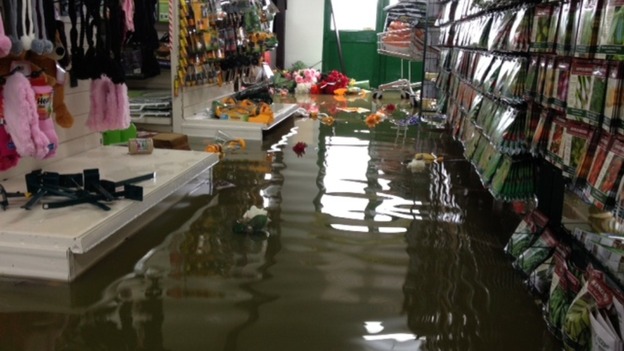How to Rescue Your Business from Disaster

Could the unexpected devastate your business? A power outage. A disgruntled or injured employee. A flash flood or hailstorm. Don't allow unexpected business interruptions caused by uncontrolled elements to knock your business into the red zone. Whatever emergencies or disasters could arise, preparing for them will help your company weather any storm.
Disasters are unwanted but often inevitable. When your business hits a bump in the road, your planning can rescue it from ruin. So how can a company plan for things outside their control? It isn't as hard as you'd think. Use our four-step action plan!
How to develop a rescue plan for business disasters
1. Figure out what could go wrong
You can do this yourself, but there are professionals who can run a vulnerability and risk assessment for you. We suggest allowing the professionals to determine your risks and vulnerabilities because they have experience, insight, and objectivity. They will assist you as far as possible in identifying what could go wrong and even assist in assessing how this could affect your business.
The assessment will indicate what threats and risks your business could face. These could include anything from infrastructure and personnel to reputation and natural disasters like hurricanes. Once the risks have been identified, the assessor will determine how vulnerable your company is and make suggestions accordingly. Is your data backup system reliable? Are your staff trained with the latest health and safety measures? Do your employees know how to prevent a theft? Are there systems in place to prevent employee theft or fraud?
The risk assessor can then help you work through what steps to prioritise to bring the necessary changes that will lower your company's risk profile. They do this by ranking your threats by frequency, vulnerability, and business impact. Let's say, as an example, employee inventory theft each year costs your company R10,000, and data loss costs you R2,000 each year. By crunching the numbers, your assessor can make it easy to see which risks need to be addressed first.
2. Establish an emergency action plan
Your risk assessment team could also help you write an emergency action plan in the form of a manual that lays out what steps to take for each type of emergency. Sometimes, how you deal with risks is prescribed by law or regulatory bodies, like the Occupational Health and Safety (OHSA)-directed evacuation plan. Here are a few practical tips/suggestions for your action plan:
- Your policies need to be written out and clear.
- They should describe the chain of command, with names and job titles of the departments and responsible people who will make decisions in the event of the specific emergency.
- Your policy should also make clear which departments and individuals will monitor response actions and reinstate operations back to normal once the threat has been dealt with.
- A list of those who will assess the degree of risk to life and property and who should be notified for each type of emergency, including their names and contact details, should be included.
- A document that details the evacuation procedures, including a meeting place outside the building or facility and a process to account for employees and civilians after the evacuation, should be readily available.
- Training and practise schedules that include the equipment needed should be clearly defined and scheduled. This training should be offered to specific employees who are responsible for things like medical duties, rescue operations, firefighting, hazard response, and any other eventualities relevant to your company and work.
- Make use of documents or posters that explain how to report various emergencies like a robbery or a fire.
- Create a document detailing the procedures responsible employees should follow to shut down critical operations before evacuation of your facility.
- Where applicable, create and document the procedure that should be followed to contact the customers if needed. For example, whether a press release, email, or a sign with information on alternate premises or the date of your return. It is important to put every element discussed here into writing.
Companies are, for instance, required to adhere to the Occupational Health and Safety Act, 85 of 1993. The South African National Standards Regulations Regarding Fire Safety and other safety measures will be useful in your planning. Where you're required to do something by law, the law will usually tell or guide you on how to comply, but not always.
Many emergencies do, however, include some basic elements for your emergency action plan. These elements can include:
3. Prepare your team to respond
When your response manuals are finalised, let everyone know. Your staff should know what the plans are, where to find them, what is expected of them personally, and where and when they will need training. It's a great idea to talk through how the plans will play out and what could happen in an emergency. In the process, you could find problems you may have overlooked. Great! The plan isn't the end goal; it's there to serve the team and the company. If it needs to be adjusted or changed, it should be done swiftly.
Your employees should know and understand all relevant protocols and procedures, like how to notify the local fire department, police department, or other relevant emergency response services for instance.
Your staff might need training on other areas that may be relevant to your company, including basic first aid, how to use a fire extinguisher, emergency notification procedures, and emergency equipment shutdown. This training could not only save your company but also the lives of your employees.
4. Create a recovery or back-to-business plan
After an emergency, getting back to business as usual can be more complicated than simply heading into the office the next day. Depending on the situation, you could be stuck without your necessary equipment, facilities, and staff.
A plan that details how your business should get back to regular operations after an emergency can save it from ruin. To create this plan, think about what your company may lack in order to proceed with business as usual for each emergency. For example, if a flash flood strikes, would your business lose the entire building or maybe just access to electricity?
You can also consider the following when drawing up your recovery plan, depending on the severity of the situation:
- If the workplace isn't accessible and usable, make sure you have alternative temporary premises.
- Have the contact information ready for a clean-up crew after a disaster.
- Ensure you have a data recovery plan if computers are damaged by fire or water.
- If something happens to one of your suppliers, make sure you know a back-up supplier.
While there's no way to guarantee that your business will weather any disaster, you can see there's a lot you can do to reduce the impact an emergency might have on your business.
If disaster does strike, make sure your business is comprehensively covered with business insurance. To find an insurer who understands your unique business challenges and needs, use the hippo.co.za business insurance quote comparison tool today.
The information in this article is provided for informational purposes only and should not be construed as financial, legal, or medical advice.
Hippo Blog Categories

































